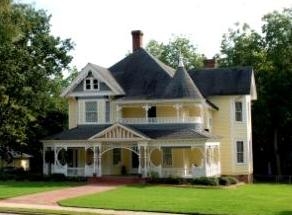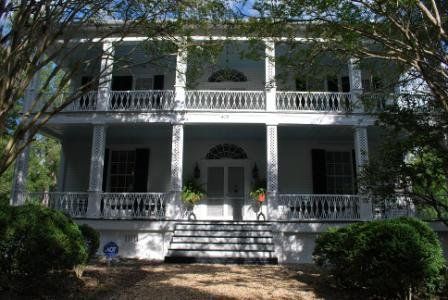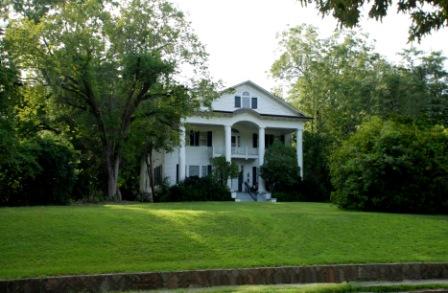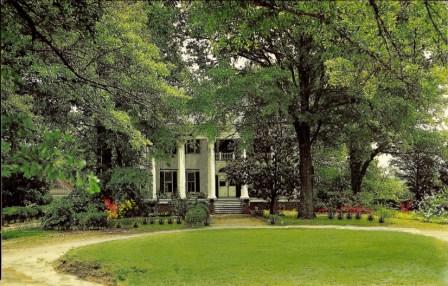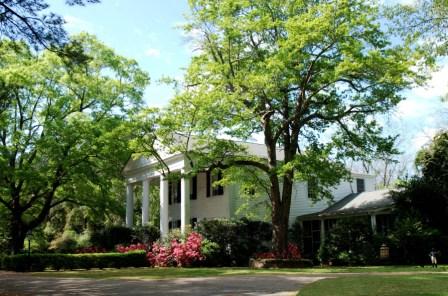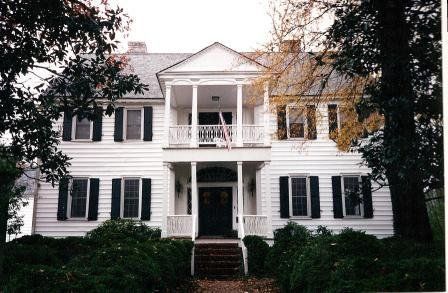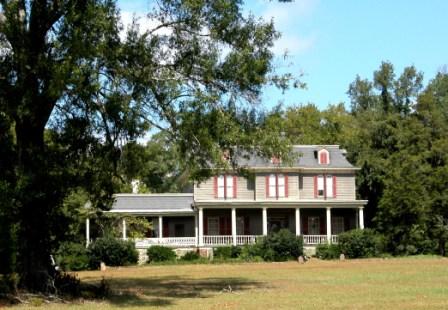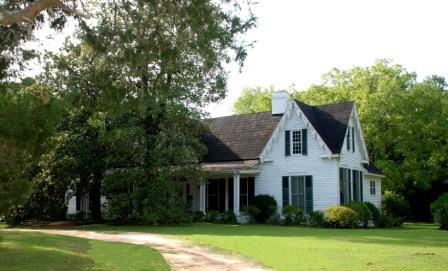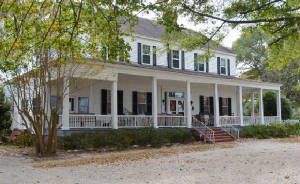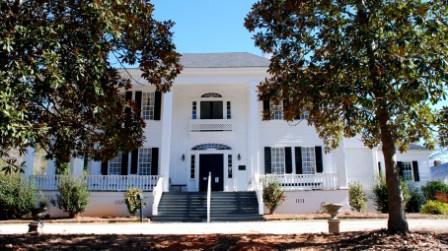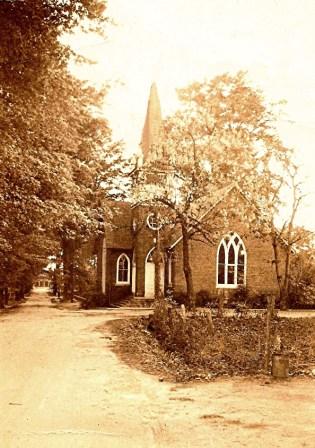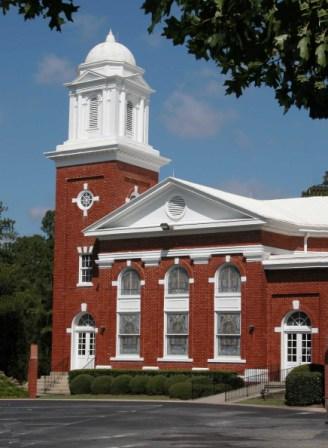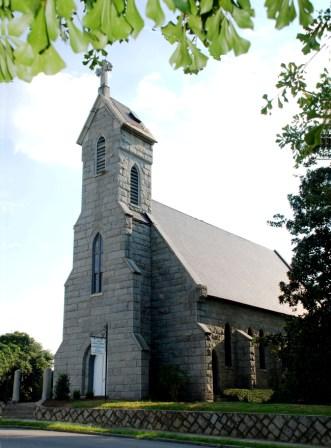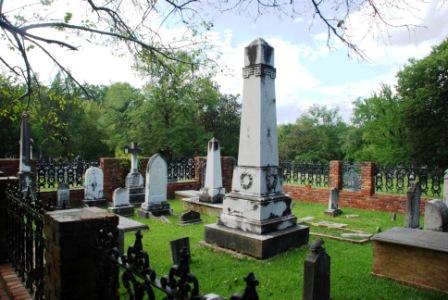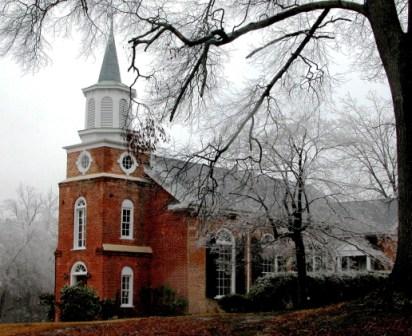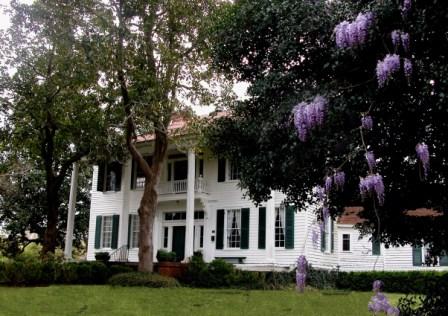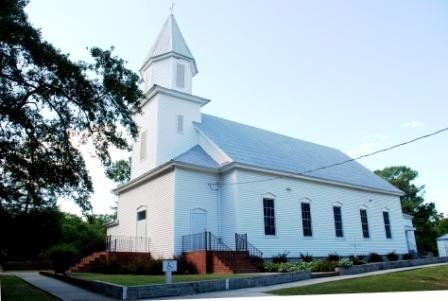HISTORIC HOMES AND SITES IN EDGEFIELD, SC
HISTORIC HOMES (Private Residences)
Adams House. This house is believed to have been built sometime around 1890 by W.W. Adams, a prominent merchant and long-time mayor of Edgefield. It is of a classic Victorian design and has been credited to George F. Barber of Knoxville, Tennessee, who published books of Victorian-era house plans in the period 1890-1910. One could order the house of his choice, and it would be delivered by boxcar. When Mr. Adams died in 1913, he was one of the wealthiest men in the town. His family continued to own the house up until the mid-twentieth century.
Halcyon Grove. A house was on this site prior to 1824 when Eldred Simkins deeded the property to Daniel Bird. Bird owned the property until 1829 when he sold it to Francis Pickens. Pickens must have given or sold the house to his father, former Governor Andrew Pickens, who sold it in 1836 to John Lipscomb, stating that the property is “where I now reside.” In 1869, Shemuel Wright Nicholson purchased the property for his daughter, Lucy Jane, widow of Capt. John Pearson Bates, CSA. The house continued to be owned by this family until 2008. This early plantation home has many interesting architectural features, including front windows with hidden doors below which can be raised and opened to allow movement from the front rooms to the front porch. Also the house has beautiful wainscoting which has been feather-painted, an intricately carved archway, a hidden staircase, bushels-of-wheat banisters with lattice columns and a magnificent fanlight over the front door.
Brooks-Tompkins House. This house was built circa 1818 by Whitfield Brooks (1790-1851), a prominent lawyer and Commissioner of Equity of the Edgefield District. His eldest child, Preston S. Brooks, who became Congressman and who attained national fame in 1856 when he caned Sen. Charles Sumner on the floor of the U.S. Senate, was born here. After his parents retired to their country plantation in 1849, Preston moved back into the house with his family. The home was later purchased by Rev. Luther Gwaltney, the well-known Baptist minister, who lived there for some years. Around the turn of the 20th century, the house was purchased by Dr. James Glover Tompkins, a prominent local physician, whose family has continued to own it until the present time. In 1924 the house was partially burned, but was rebuilt by Dr. Tompkins, using many of the architectural adornments of the original house, including mantelpieces, wainscotings and fanlights. The elaborate carvings are of an unusual style in Edgefield, only found in one other house, Holmewood.
Pine House. This historic landmark dates from 1757 when a tract of 200 acres “known by the name of the Piney Wood House” was surveyed for Richard Pace. It was located at the junction of two important trails: one from Augusta to Columbia and the other from Charleston to Ninety Six. In 1786 the property was acquired by Van Swearingen who operated it as a Tavern. President George Washington dined here on May 21, 1791 during his Southern tour. In 1811 it was purchased by Francis Bettis of the Horn’s Creek section. General J.R. Wever purchased property across the Augusta and Columbia Road from the tavern in 1847 and erected “the Wever Mansion.” This Greek Revival house was purchased in 1858 by Benjamin Warren Bettis, who renamed it “the Pine House.” It partially burned in 1868 and was rebuilt shortly afterwards. Julius M. Vann, Sr. bought the house in 1933 and it remains in that family into the 21st century. The 1757 Piney Wood Tavern across the road was dismantled early in the 20th century.
Holmewood. Built in 1832 by William Prothro, a wealthy planter, and his wife, Sara Ann Lowe, a granddaughter of Edgefield founder Arthur Simkins, Holmewood is one of the largest houses in Edgefield with some of the finest hand-carved woodwork in the area. The house was purchased in 1846 by Francis Hugh Wardlaw (1800-1861), a prominent local lawyer and judge of the Chancellery Court who lived here until his death in 1861. Wardlaw is best remembered as the author of the South Carolina Ordinance of Secession. Between 1865 and 1875, former Governor Milledge Luke Bonham (1813-1890) lived here with his family. Governor Bonham had been a U.S. Congressman, Confederate General and second War Governor of South Carolina. In 1903 the property was purchased by Thomas Hobbs Rainsford (1861-1932) whose family has resided here ever since.
Carroll Hill. Built in 1842 by James Parsons Carroll, a prominent lawyer of Edgefield, and his wife, Eliza Anciaux Berrien of Savannah, Carroll Hill has unique architectural features that include a floor plan with the hallway on the side and a floating staircase, which suggest the Savannah origin of its first mistress. The Carrolls lived here until 1859 when they moved to Columbia so that he could assume a position there as a judge of the Chancellery Court. At this time, his niece, Ellen Brooks Dunovant, and her husband, R.G.M. Dunovant, moved into the home. Dunovant was a prominent military figure in South Carolina, having served as Colonel of the Palmetto Regiment in the Mexican War and as a Brigadier General in the Civil War. The Dunovant family has continued to own this property for nearly 150 years.
Cedar Grove. This is one of the earliest of the grand plantation houses of Edgefield County. Built by a prosperous early settler, John Blocker, sometime between 1790 and 1805, this house has many remarkable architectural features, including a curved ceiling in the hallway, elaborately carved mantelpieces and hand-painted French wallpaper. The gardens were reputedly laid out by Andre Michaux, the renowned botanist who had designed the gardens at Middleton Place in Charleston. The house was purchased in 1825 by John Bones, a wealthy Augusta merchant, for his parents who had immigrated from Ireland. It was handed down through the Bones, Hughes and Nicholson families who continued to own it until 1973. The famous boxwoods of Cedar Grove were sold during the Depression to the Rockefeller family and placed in the gardens of the Governor’s Palace in Williamsburg.
Carnoosie. This home, which was originally built by M. Lebeschultz in 1860, as a one-story structure, is principally remembered as the home of the Sheppard family. The home was purchased in 1884 by John Calhoun Sheppard, a prominent lawyer, politician and businessman who became Governor of South Carolina in 1886. The house was first enlarged by the addition of the west wing and later, in 1891, by a second story. Sheppard continued to be active in state and local politics and business for more than four decades. His son, James Orlando Sheppard (1890-1973), who followed in his father’s footsteps by becoming Lieutenant Governor of South Carolina during the 1920s, also lived here until his death. The name “Carnoosie” is reputed to be a Cherokee word for cornfield, but it is unclear why and when the name was first applied to this house.
East Hill. This early Victorian home, completed in 1859 for James Henry Mims, is very unlike other homes in Edgefield in that it is primarily one-story with five main rooms across the front. It bears unique Victorian architectural features, including gingerbread trim around the front porch and wide openings between the rooms, with multiple hinged doors. The house was purchased by General Matthew Calbraith Butler in 1870. Butler had been a Major General in the Confederate Army and played a leading role in the 1876 Red Shirt Campaign to restore Democratic government to South Carolina. He was elected to the United States Senate in 1877 and served until 1895. Afterwards he was commissioned as a Major General in the Spanish American War. In 1904 the house was purchased by Senator Benjamin Edwin Nicholson whose family continues to own the house today.
Darby. Built by Nathan Lipscomb Griffin in 1842, this home was acquired by his son-in-law, Milledge Luke Bonham, in 1858. Bonham was a Congressman, Governor and Confederate General. He lived here before the War and then later during Reconstruction. In 1863 Bonham sold Darby to George Trenholm, a blockade runner who was reputedly the inspiration for Rhett Butler in Gone with the Wind and who subsequently became the Confederate Treasurer. Trenholm allowed his friend Professor Francis Simons Holmes of the College of Charleston to refuge here during the War. Holmes brought many artifacts from the Charleston Museum and stored them at Darby. The house was purchased in the late 19th century by Walter S. Miller. After his death, his widow left the property to her nephew, Douglas L. Wise, who owned the house until his death. Darby was listed in the National Register of Historic Places in 1974. In 2012 the Society installed a historic marker (Marker Number 19 20) at the roadside.
HISTORIC SITES
Edgefield County Court House. The site of the court house for Edgefield County was first chosen in 1785. A “gaol” was built here as early as 1785. The original court house, a weather-boarded building constructed in 1787 – 1788, is believed to have been located in the center of the “Publick Lot.” It was not until 1792 that Arthur Simkins, one of the Judges of the County Court, acquired title to this property and then deeded to the “Honorable Judges of the County Court” two and a quarter acres “whereon the Court House and Jail now stand.” A second court house built of brick, circa 1809, was improved by Robert Mills with the addition of porticos on either side in 1826. The present court house, our third one, was completed in 1839. Although it was not designed by Robert Mills who had already gone to Washington, it was certainly “inspired” by him as it was designed and constructed by his longtime protégé, Charles Beck, and includes more of the distinctive Mills features than almost any court house designed by Mills himself. In an 1839 editorial, the Edgefield Advertiser noted that the new court house “is a large and noble looking building . . . . It may be truly said that the style of the building is chaste and that it is an ornament to the village.”
The Discovery Center. The Joanne T. Rainsford Discovery Center of the South Carolina National Heritage Corridor was built in 1840 by Captain James Miller, a wealthy planter and captain of an Edgefield militia company. It was moved in 1992 from its original location some seven miles south of Edgefield on U.S. Highway 25 to its Main Street location in Edgefield. The original house, prior to being moved, had heavy plaster moldings, unique painted designs on the ceilings and a second-floor ballroom. When reconstructed after its move to Edgefield, the ballroom was not reproduced and changes were made to make the house more suitable for a museum. The house, which had been known as “Magnolia Grove” prior to its removal, was renamed in memory of Joanne T. Rainsford (1949-1997), the president of the Edgefield County Historical Society and one of the founders of the South Carolina National Heritage Corridor.
Oakley Park. Built in 1835 by Daniel Bird, a prominent planter who had a special interest in architecture, Oakley Park was acquired by Col. Marshall Frazier in 1840. He lived there until his death in 1870. Several years later it was purchased by General Martin Witherspoon Gary, a former Major-General of the Confederacy. It was used as his headquarters in 1876 when he was the leader of the Red Shirt movement, a campaign to restore Democratic government to South Carolina. After Gary’s death in 1881, it was home to various members of his family until 1941 when Gary’s nephew, Governor John Gary Evans, gave the property to the Town of Edgefield and the United Daughters of the Confederacy. Today, Oakley Park is a house museum and is open to the public.
Edgefield Methodist Church. Although there had been Methodist services in Edgefield as early as 1790, and there had been a Methodist Church at Pottersville as early as 1820, the first Methodist Church in Edgefield was organized in about 1830 and the first church building erected in 1831. This first church was located on the Cambridge Road (now Buncombe Street) about a half-mile from the Court House between the Adams-Mims House and Holmewood. In 1839 and 1841 property closer into town, between Main Street and the present Norris Street, was acquired for a new building which was constructed at that time. The Rev. Joseph Moore, an early Methodist minister who had done much to help build Methodism in Edgefield, donated this land for the Church. In 1891 & 1892 the present building was constructed on the corner of Norris and Bacon Streets. The old church building which faced Bacon Street was converted into a parsonage and remained there until 1957 when it was torn down and the present parsonage constructed.
Edgefield Village (First) Baptist Church. Organized in 1823, this church has been one of the most influential churches in South Carolina. It was in this church in 1826 that Furman University was conceived and founded. The land for the church was given by Eldred Simkins with a broad subscription from all over the county. The first moderator was Arthur Simkins, the first clerk, Matthew Mims, and the first pastor, Basil Manly. Later pastors of note include William Bullein Johnson, founder and first president of the Southern Baptist Convention, Luther R. Gwaltney and Dr. Robert G. Lee, who first wrote and delivered his famous sermon “Payday Someday” while he was here. Dr. John Lake (1870-1949), ordained in this church, went on to become a missionary to China where he founded the Tai-Kam Leper Colony. The 1823 church building was a wooden structure which was torn down in 1889. A second building was erected of brick in that year, but it was struck by lightning and burned in 1913. The present church was built in the following year.
St. Mary of the Immaculate Conception Catholic Church and Cemetery. Built between 1858 and 1860, primarily through the efforts of Father Timothy Bermingham, a native of Ireland, this church had the support of a number of prominent Edgefieldians, including Dr. John Harwood Burt and Dr. Elbert Bland. It was designed by Mr. John Rudolph Niernsie (1831-1885), the architect of the State House in Columbia, and built out of local granite by itinerant stonecutters and masons, under the supervision of Mr. Pat Whelan, foreman. The altars were imported from Italy. The church is one of the most significant structures of its kind in South Carolina. The adjacent cemetery contains the graves of several Confederate soldiers, including that of Dr. Harwood Burt, the father of Catholicism in Edgefield County.
Willowbrook Cemetery. Sometimes known as the Edgefield Village Cemetery, Willowbrook dates back to as early as 1819. It is believed that the first person buried here was Pierre LaBorde, Edgefield’s first merchant, who died in 1819. Although it is adjacent to the Baptist Church, the cemetery predates the church which was built in 1823. Many famous South Carolinians are buried here, including four of our state’s governors (Francis W. Pickens, John Gary Evans, John C. Sheppard and Strom Thurmond), two of our United States Senators (M.C. Butler and Strom Thurmond), a famous congressman (Preston S. Brooks), a remarkably accomplished missionary to China (Dr. John Lake), the author of the South Carolina Ordinance of Secession (Francis Hugh Wardlaw), a Revolutionary veteran and approximately 150 Confederate veterans. Of special interest is a large rock brought here from the Tai Kam Leper Colony in the South China Sea to mark the grave of Dr. John Lake who founded the Colony.
Trinity Episcopal Church. This church was organized in 1835 and the building was completed in 1836. It was a classical building with Palladian windows and a portico on the front. In 1886 the Victorian church tower was built, eliminating the original portico. Unfortunately no photographs or descriptions of the original portico have survived. In 1951 the upper portion of the tower was replaced by the present steeple. Among the original leaders of the church were Whitfield Brooks and his wife, Mary Parsons Carroll Brooks, James Parsons Carroll, Francis Pickens, Andrew Pickens Butler, Francis Hugh Wardlaw and Edmund B. Bacon. Significant memorials in the church include stained glass windows to Edward Tabb Walker, a longtime rector, and James T. Bacon, longtime newspaper editor and organist at the church, marble tablets to Whitfield Brooks, prominent lawyer and planter, Whitfield Butler Brooks, a valiant soldier who died in the War with Mexico and Francis Butler Simkins, one of the greatest Southern historians of all time, and a baptismal font to the daughters of James Parsons Carroll.
Magnolia Dale. This home was built on the site of the first residence in Edgefield, built by Peter Youngblood and dating from approximately 1762. The property was later the home of Erasmus J. Youngblood who sold it in 1843 to Samuel Brooks of Connecticut. It is thought that Brooks built the present house as early as 1843. In 1873 Brooks’ daughter sold the property to Alfred J. Norris, a prominent lawyer and businessman. In 1875 his daughter, Mamie Norris, was born here. She later married James Hammond Tillman who became Lieutenant Governor of South Carolina. After her husband’s and her parents’ deaths, Mrs. Tillman continued to reside here. In 1929 the house was sold to the Kendall Company, but Mrs. Tillman continued to live here and in 1959 she prevailed upon the Company to give the property to the Edgefield County Historical Society. Today the house is the headquarters of the Society and is open by appointment as a house museum. Interesting artifacts in the house include portraits of Arthur Simkins (1742-1826), his wife Margaret Dalby, Edmund Bacon (1776-1826), his wife Eliza Fox and the daughters of Francis Pickens, a sideboard belonging to Governor George McDuffie, the dining room table of Governor and Senator Benjamin Ryan Tillman and many interesting items in the Strom Thurmond Room.
Macedonia Baptist Church. Formed in the years right after the War Between the States when both blacks and whites were choosing to create separate churches for each race, Macedonia was built on four acres purchased from Mrs. Rebecca Bland in 1869. Its founding members had primarily been members of the Edgefield Village Baptist Church (now First Baptist) and included Peter Johnson, Paris Simkins, Andrew Simkins, Laurence Cain, George Simkins and Robert A. Green. The present church building was completed in 1901. The cemetery behind the church contains the graves of many remarkable members, including Katie Ramey, whose white husband, W.D. Ramey, is buried in Willowbrook Cemetery near the First Baptist Church and Paris Simkins, the son of Arthur Simkins, the longtime editor of the Edgefield Advertiser .


